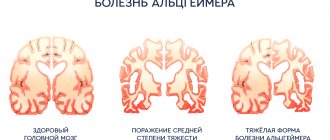Obsessive thoughts are uncontrollable urges that arise on a subconscious level. They lead to fears and anxieties, inadequate negative fantasies, and deterioration of mental health. Without proper treatment, obsessions become the cause of depressive moods, neuroses, schizophrenia, mental exhaustion, and a hermit lifestyle. The main characteristics of the disease are as follows:
- the individual does not influence the appearance of anxious and bad thoughts, they appear against his will;
- ideas that forcibly invade the mind do not arise as a result of habitual conclusions, but are isolated, alien images;
- the disease cannot be eliminated from your life with just one effort of will;
- Symptoms include severe anxiety, increased irritability;
- the patient does not lose clarity of mind and recognizes his illness.
It is precisely because of the awareness of the deplorability of his situation that the patient feels bad. He admits his deviations, but cannot fight them. All attempts to eliminate obsessive thoughts from consciousness cause even greater anxiety and fear. It is easy to convince the patient that all his incomprehensible fantasies have no proper basis. The person admits this, but the disease continues to progress. More and more new obsessions appear. Here are the most striking examples of “sticky” thoughts:
- fears about the spread and infection of diseases;
- adherence to principles in ensuring order and symmetry;
- uncontrolled obsessive counting;
- fear of force majeure, the end of the world;
- groundless and unreasoned exclusion of specific actions;
- thoughts about faith, sex, excessive aggressiveness that arise without the desire of the patient.
Obsessions lead to negative behavior and a state of increased tension. The patient himself cannot cope with his experiences, although he admits that he has a problem and that they are unfounded. It is possible to improve your condition and get rid of false ideas of reality only by receiving competent medical care.
Treatment of obsessive thoughts
The Salvation Clinic treats obsessive thoughts using progressive techniques and proven pharmacotherapy. Our staff includes highly qualified psychologists and psychotherapists who have experience and the opportunity to travel to various international conferences. The clinic provides decent conditions for keeping patients, nutritious food, and leisure. The patients do not need anything. It is possible to install an individual nursing station and rent a VIP room. The clinic has specialized security. No one will be able to enter or leave unnoticed. We strive to alleviate the condition of our patients and bring recovery closer. Contacting our center will improve the patient’s quality of life and provide the opportunity for a full-fledged existence.
Patients are treated individually. The program is developed on the basis of long-term observations of the patient’s behavior, his state of health, tests, taking into account age. The greatest effect of treatment is achieved with a combination of psychotherapy and drug therapy. Medicines (tranquilizers, antidepressants and antipsychotics) allow you to:
- correct neurotic symptoms;
- remove anxiety and fears;
- control mood and behavior.
Psychotherapy is an integral part of treating obsessive thoughts. Through individual counseling you can:
- understand the nature of the occurrence of deviations;
- eliminate the cause that led to the disease;
- eliminate fears and anxieties;
- develop stress resistance and self-confidence;
- eliminate depressive moods;
- teach how to manage symptoms;
- help a person socialize.
In their practice, our center’s specialists use the following approaches:
- Cognitive behavioral therapy. Based on the theory of behaviorism and the cognitive approach. The latter implies that deviations in mental development are provoked by illogical thinking and incorrect beliefs of the individual, by eliminating which it will be possible to get rid of obsessive thoughts and anxieties. Adherents of behaviorism recognize that the main influence on the mental development of an individual and his behavior is exerted by genetic predisposition, but they also attach important importance to environmental factors. By eliminating support for undesirable behaviors and encouraging desirable ones, a person's habits and lifestyle can be changed.
- Hypno-suggestive techniques. Verbal and non-verbal influence is made on the consciousness of the individual in order to introduce the necessary attitudes and programs. During the session, control is removed, attention is reduced, and the opportunity to program consciousness opens up. As a result of hypnosis treatment, motivation to action, changes in state and behavior are produced. The suggestive instructions given by the doctor penetrate deeply into the patient’s subconscious, which ensures positive dynamics of treatment. When using hypno-suggestive methods, depression, neurosis, phobias, alcoholism, smoking, drug addiction are successfully treated, and obsessions are eliminated.
- Autotraining. Allows you to restore the function of self-regulation impaired due to stress. The method is based on the use of self-hypnosis, self-education, and muscle relaxation. The advantage of auto-training is the involvement of the patient in the treatment process. There are two stages of training: higher and lower. At the initial stage, relaxation exercises, training of the cardiovascular system, and training in the principles of proper breathing are performed. As a result of treatment, the patient’s general well-being, blood supply to the brain and internal organs improves, the heartbeat normalizes, and headaches are relieved. At the highest stage, training is carried out to induce certain complex experiences by introducing the patient into trance states of varying depth and intensity.
We guarantee the correct diagnosis and improvement of the patient’s condition. The treatment regimen for obsessive thoughts is developed collectively. We focus on the complete elimination of symptoms and a return to an independent active life without worries and restrictions.
How to treat obsessive-compulsive disorder?
Obsessive-compulsive disorder, the treatment of which depends on the nature of the course, clinical picture, symptoms and mental characteristics of the patient, has common principles in organizing therapy. This is, first of all, a comprehensive treatment that combines the following main areas: • Drug therapy, which is selected strictly individually, taking into account the characteristics of OCD symptoms, gender, age, and the presence of concomitant diseases. Pharmacotherapy for OCD uses tranquilizers, SSRI antidepressants, MAO inhibitors, beta blockers to relieve autonomic symptoms, as well as antipsychotics. Therefore, self-medication is categorically excluded, because only a psychiatric specialist can assess all the risks and effectiveness of using certain drugs, develop a competent treatment regimen and prescribe the correct dosage. What is the difference between a psychotherapist and a psychiatrist. • Psychotherapy, the main goal of which is to instill in the patient faith in the success of treatment, overcome his fears about the prescribed psychotropic drugs, and convince him of the need to strictly follow the treatment regimen developed by the doctor. All this can be achieved only on the basis of a trusting relationship between the doctor and the patient and with the active support of the patient from his relatives. If the patient has ritual actions, such a method of psychotherapy as creating conditions for aggravating the situation while simultaneously blocking the reaction to what is happening is quite effective. As a result, rituals become less pronounced, and with their “depreciation,” obsessive thoughts go away. When treating panphobia, behavioral psychotherapy has a good effect, but it should be borne in mind that it is ineffective in treating obsessive “non-ritual” thoughts that are not accompanied by rituals.
In the first stages of treatment for OCD, the patient should be explained the nature of the symptoms that are disturbing him, reassure him that he is not going crazy (patients with OCD are quite often convinced of this) and establish psycho-emotional contact with him. It is important to enlist the support of the patient’s relatives, who should not indulge his obsessions, but at the same time be sympathetic to his condition and try to soften the psychological situation.
It should be noted that psychotherapy, for all its importance, cannot replace drug treatment. Explanatory and educational psychotherapy alone may be counterproductive, as in some cases it leads to an increase in the intensity of negative thoughts about the topics discussed. Only complex treatment is most effective, and long-term use of pharmacological drugs is necessary to prevent relapses.
As for prognosis, 2/3 of OCD patients experience improvement after treatment for a year, towards the end of this period. If improvement occurs after 1 year, then during the course of the disease there is an alternation of periods of remissions and exacerbations. In especially severe, advanced and complex cases, OCD symptoms turn out to be extremely resistant to treatment and do not change even after 13-20 years of illness. Timely seeking psychiatric help allows you to achieve stable and long-term remission that lasts for years. This is why knowledge of the main signs of OCD is so important - their early detection in yourself or loved ones should alert you and force you to seek help from specialists as quickly as possible.
Obsessive thoughts and fears
Obsessions bring significant discomfort to the patient’s life. He cannot get rid of the desire to succumb to them, to correct the situation. What causes compulsions? This is a syndrome that occurs at certain intervals as a result of compulsive behavior. In its absence, the patient experiences a feeling of anxiety. Resistance to urges ceases when a person can no longer resist the obsessions. The most common “rituals” in this case:
- cleansing (a person is obsessed with the idea of bringing perfect cleanliness to the house, this also includes frequent washing of hands and body);
- satiety (the patient has an excessive appetite amid concern about controlling his body weight);
- ensuring security (a person constantly checks whether the door is locked, whether all electrical or gas appliances are turned off;
- observance of rationality (the patient zealously adheres to the regime, places objects in a certain order, steps over cracks in the asphalt);
- bookkeeping (the patient involuntarily monitors the number of things around him).
A person’s behavior during forcibly invading fantasies may look quite ordinary and does not arouse suspicion. However, a person is unable to renounce performing compulsive “rituals” due to anxiety that something terrible might happen. He is simply forced to carry out the actions to which his anxious thoughts are pushing him. Unfortunately, after the ritual, the person does not feel relief. And the fear of trouble pushes him to even more fanatical execution of actions imposed by alien thoughts. With this behavior, obsessive-compulsive disorder develops. The disease progresses mainly between the ages of 10 and 30 years. People with a high level of intelligence are most susceptible to the disease. In addition to this disease associated with obsessions, there are others.
Phobia
Translated from Greek, this term means “unhealthy fear.” It arises as a result of certain actions, situations, objects, people, animals. A person is panicky afraid of an irritant that causes fear. In some cases, phobias cause an inappropriate reaction, leading to aggression. Deviation can occur as a result of severe stress, overwork, nervous tension, or mental disorder. To date, a large number of phobias have been identified. The most common among them are:
- fear of open/enclosed spaces or crowded places;
- fear of swimming;
- fear of blood;
- fear of specific animals, insects;
- fear of loneliness;
- fear of touching money.
Phobias are often accompanied by panic attacks. A person imagines a quick end, as a result of which he may experience:
- numbness of hands and feet;
- labored breathing;
- discomfort in the heart area;
- diarrhea;
- dizziness.
All this affects the patient’s quality of life and requires immediate medical intervention. Treatment for a phobia depends on its type. In this case, he uses the principle of “knocking out a wedge with a wedge.” The patient is allowed to face his fear. However, this technique is associated with a strong emotional shock and does not always pay off.
Neurasthenia
The disease is characterized by excessive irritability, rapid fatigue, and loss of ability for prolonged mental and physical work. Pathology can be triggered by psychological trauma, nervous tension at work, chronic lack of sleep, lack of proper rest, chronic intoxication, infectious diseases, unhealthy diet, and endocrine disorders. The disease is accompanied by:
- frequent headaches;
- disruptions in the functioning of the cardiovascular system;
- disturbance of sleep and wakefulness;
- diarrhea/constipation.
The most favorable prognosis for treating neurasthenia at the initial stage. A change of environment, work, streamlining of the daily routine, and proper rest can help. In advanced cases, hospitalization in a specialized hospital and the prescription of pharmacotherapy, including restorative drugs, antidepressants and tranquilizers, may be required. With proper treatment, complete recovery can be achieved.
Schizophrenia
Schizophrenia is a difficult to diagnose complex mental disorder associated with inadequacy, unpredictability of behavior, insanity, illogical thinking, and detachment from society. The disease is most common in people aged 14 to 35 years. Symptoms include:
- delusional ideas;
- depressive moods;
- decreased mental and motor activity;
- deterioration in concentration;
- persecution mania;
- auditory hallucinations;
- bouts of hysteria or crying for no reason;
- delusions of grandeur;
- slurred speech;
- sloppy appearance.
The disease can be triggered by severe stress, mental stress, and heredity. Although there have been cases of sudden onset of schizophrenia with complete mental comfort.
To make an accurate diagnosis, it is necessary to observe the patient’s behavior for a long time (at least 6 months), communicate with the patient’s relatives, general and biochemical blood tests, a clinical study of the immune status, hormonal profile, magnetic resonance therapy to exclude brain diseases that may cause tumors, abscesses, and viral encephalitis.
Symptoms of obsessions and compulsions
Treatment of obsessive-compulsive disorder in Moscow at Dr. Isaev’s clinic is carried out successfully, since an individual approach is taken to each patient and only modern techniques are used. Therapy begins with identifying symptoms of deviation. The main signs of a violation are:
- presence of obsessions (obsessive thoughts);
- anxiety, tension and fear associated with them;
- compulsions (the same actions that allow you to get some relief).
All these manifestations form a single cycle, which repeats from time to time. Some patients have a predominance of obsessions, others have a predominance of compulsions, and there are also patients with the same severity of obsessive thoughts and actions.
Since the manifestations of the disease are not always typical, diagnosis requires consultation with an experienced psychiatrist and psychotherapist. To make an appointment, you can call or leave a request on the clinic’s website.
Mental symptoms
The disease is a mental disorder and is accompanied by characteristic symptoms. The patient's obsessive thoughts may include the following:
- fear of getting infected, getting dirty;
- unreasonable concern for the life and health of loved ones;
- fear of discovering that you are gay;
- sexual images and fantasies;
- constant desire for order and symmetry;
- excessive superstition, passion for ritual and cult phenomena.
With obsessive compulsive disorder, the thoughts and images that constantly come to him are perceived by the patient himself as his own. This disease differs from split personality, when the patient hears “voices” from the outside or from his “other self.” With neurosis, a person tries to control thoughts and movements, but he fails to do this. The more he resists, the more anxiety and desire to perform the ritual grows.
The most common compulsive movements associated with this disease are:
- plucking or pulling out body hair;
- constant washing of hands and body;
- nail biting;
- wiping door handles and other objects;
- checking the stove, iron, door lock;
- arranging things in strict order;
- accumulation of unnecessary trash;
- frequent utterance of prayers, mantras and other phrases.
Doing these actions itself does not bring much pleasure, but it can reduce the level of tension, fear and anxiety. But this only lasts for a while, and then obsessions arise again and the phobia grows, and the cycle repeats. Compulsions may outwardly look like normal work, this applies to putting things away or cleaning the house. In some cases, they have no rational basis, for example, jumping over asphalt cracks. But for the onset of calm, a person performs them without fail, but at the same time is fully aware of their uselessness and absurdity.
Physical signs
Treatment of obsessive-compulsive disorder in Moscow at Dr. Isaev’s clinic includes providing assistance to relieve mental symptoms and eliminate physical signs of pathology. Patients with obsessional neurosis often experience dysfunction of the autonomic nervous system. And this leads to the following deviations:
- insomnia;
- dizziness;
- heartache;
- headache;
- frequent blinking;
- seizures and tics;
- pressure surges (hypo- and hypertensive crises);
- loss of appetite;
- dyspepsia;
- increased sweating and chills;
- tachycardia;
- dyspnea;
- dry mouth;
- decreased libido, impotence.
All these disorders are complications of the underlying pathology. And with proper complex therapy they go away on their own. In some cases, additional treatment is required to speed up the restoration of autonomic functions.
The method of providing assistance also depends on the type of neurosis. It happens:
- chronic (from 2 months or more);
- recurrent (with periods of exacerbation and “bright” intervals);
- progressive (continuous manifestation with gradual deterioration).
When the disease becomes chronic, and the reason for this is often the lack of professional therapy, the type of obsessive states expands. If at the beginning of the disease a person could check that the stove or iron was turned off 2-3 times a day, then later this action begins to be repeated 5-6 times. With a progressive form of pathology, performing rituals can take the patient most of the day and there is no time left for other types of activity.
Causes of obsessive thoughts
It is difficult to establish exactly the nature of the occurrence of alien anxious thoughts. This is most associated with the underlying disease. May also affect:
- heredity;
- hormonal imbalance, due to which there is a dysfunction of the brain;
- psychological trauma;
- severe stress;
- sensitive temperament;
- pregnancy;
- disability;
- the presence of protracted infectious diseases.
A qualified psychiatrist can determine the causes of obsessive thoughts. Required:
- personal consultation;
- conducting experiments to see the overall clinical picture;
- interviewing the patient's relatives;
- observing his behavior;
- use of a neurophysiological test system and neurotest;
- carrying out laboratory tests.
Treatment of obsessions is carried out in conjunction with the underlying disease. Depending on the patient’s condition, it can be performed in a hospital or in an outpatient setting.
OCD symptoms
OCD symptoms fall into two categories: obsessions and compulsions. Intrusive thoughts ( take the obsession test ) are recurring thoughts or urges that cause anxiety. These thoughts may be rooted in disgust, guilt, or fear. Obsessions often involve one of the following themes:
- Cleanliness: frequent thoughts about illness, dirt, etc. Patients overestimate the threat of contamination.
- Lack of order: Obsessions are often related to symmetry and completeness. The person may feel that something is out of order or “out of balance.” These are exaggerated perfectionistic tendencies and the need for control.
- Fear of harm. Often thoughts arise about accidents, injuries, etc. A person may be afraid of harming himself or loved ones. Patients may feel responsible for preventing tragedies by acting out their compulsive behaviors.
- Forbidden thoughts: This category includes intrusive thoughts about committing some taboo. For example, one person may be afraid of losing control and at the same time mentally swear during a business meeting. Another may imagine setting a building on fire, even though he doesn't want to do it.
Someone may have obsessions in multiple categories. Themes of obsession may change over time. When a person's obsessions are united by a religious theme, it is called religious OCD or obsession.
Obsessions can cause serious distress when they conflict with a person's ethics and character. However, such thoughts do not coincide with intention. A person with obsessive thoughts about hitting pedestrians is unlikely to commit murder. On the contrary, he is likely to be a more careful driver than the average person because the idea of harming others bothers him greatly.
How to get rid of obsessive thoughts in your head
Obsessions are a real reason to visit a doctor. Only with the help of a specialist will it be possible to eliminate inappropriate ideas. You should not try to find a way to improve your well-being on your own. Self-medication can lead to worsening of the condition, progression of the disease, dependence on drugs and alcohol, in which the patient seeks solace. However, they only aggravate the situation, as they can cause delusions and hallucinations.
Heart-to-heart conversations help with obsessions. Relatives and people with similar problems will understand better. It may be advisable to sign up for group psychotherapy. However, even the closest people are not always ready to listen. Optimally, contact a good psychiatrist. In addition, you must:
- understand your desires;
- do not forget about self-control;
- adhere to the treatment regimen;
- learn more about your condition;
- accept the problem;
- realize the need for treatment;
- get enough sleep;
- adhere to the rules of good nutrition;
- give up alcohol and other psychoactive substances;
- lead an active lifestyle;
- avoid nervous fatigue and anxiety;
- be distracted by relaxing with family and friends, building a career;
- there is no need to allow obsession to interfere with a full existence.
Our clinic specialists are ready to listen to you right now. We provide on-site consultations and guarantee complete confidentiality. Highly qualified doctors will be able to correctly diagnose and offer an effective solution to eliminate the problem.
Questions and answers
Can obsessive compulsive neurosis go away on its own?
Mild forms of obsessive-compulsive neurosis can go away on their own. This usually happens after a bright and memorable event, when thoughts are crowded out and replaced by interesting work, a change of place of residence, or the birth of a child. In some cases, the disorder gets better with age. But over a period of time, the disease greatly reduces the quality of life and distracts from completing tasks.
When and which doctor should I contact?
You should consult a doctor if you experience disturbing and obsessive thoughts that have no rational basis. At the same time, no amount of willpower or desire to be distracted helps eliminate their influence. To solve the problem, you need to contact an experienced psychotherapist or psychiatrist.
VSD and obsessive thoughts
Against the background of symptoms of vegetative-vascular dystonia, obsessions can arise out of the blue. The person panics and feels helpless. “Sticky” thoughts are primarily associated with deteriorating health. The patient may be bothered by sharp pain in a specific organ, which quickly passes. There is rapid fatigue, apathy, a feeling of lack of air, heaviness in the heart area. All fears associated with fear for health come down to thanatophobia. This is the fear of death. Because of this, the nervous system is in constant tension, the situation gets worse. A sick imagination can also paint pictures of the death of loved ones. When you are forbidden not to think about such things, a person plunges even more into the abyss of his phobia. Presents a variety of colorful variations. Relatives must take the patient’s complaints seriously, otherwise the gap between them will only grow.
Compulsive symptoms in OCD
People with OCD often use compulsive behaviors ( take an OCD test ) to control their obsessions. For example, an anxious patient checks the smell of his breath. Some actions are taken to relieve stress (although there are more effective methods), others are aimed at preventing a dangerous event. A compulsive action does not necessarily have a logical connection with an obsession. For example, a child may count steps to prevent the death of a parent. However, if actions and thoughts are related, the action will be very disproportionate to the risk.
Obsessive-compulsive behavior is frequently and excessively repeated. It almost always interferes with everyday life. Some people feel forced to spend hours on their compulsive needs. Others may go out of their way to avoid certain triggers. Many people with OCD know that their behavior is not “logical”, but they still feel anxious and confused until they complete the necessary “ritual”.
Depression with obsessive thoughts
The disorder can lead to depression. A person is constantly in a depressed mood and loses the ability to rejoice. There are other symptoms of the disease:
- low self-esteem;
- loss of interest in life;
- impaired concentration;
- obsessive feelings of guilt;
- bad attitude;
- disturbance of sleep and wakefulness;
- refusal to eat;
- thoughts of suicide;
- tendency to use alcohol and drugs;
Depression is one of the more common mental disorders. Recent advances in the field of pharmacotherapy and psychiatry make it possible to achieve complete recovery in 96.7% of cases.
What is OCD?
Intrusive thoughts are persistent, unwanted thoughts about a specific topic. Obsessive actions (compulsions) are repeated physical or mental actions that the patient considers himself obligated to perform. Patients diagnosed with obsessive-compulsive disorder (OCD) often act out their obsessions.
For example, a person may constantly worry that his house will be robbed. To cope with anxiety, a person checks the locks on his doors ten times a night. These behaviors may not actually prevent a robbery or break-in, but the person experiences significant distress if they do not follow these steps.
These conditions usually appear around the age of 19, although in a quarter of cases the onset begins before the age of 14. OCD can affect people of all ages, social classes and ethnic groups.
OCD can last a lifetime if left untreated. Symptoms can interfere with work, relationships, and overall well-being. A psychotherapist can help patients get rid of symptoms and learn to cope with difficulties.
Obsessive thoughts in neurosis
Such a diagnosis can be made when a person has been tormented for a long time by “sticky” thoughts and urges to realize them, feelings of fear and anxiety. Obsessive ideas and actions are observed to be hyperbolic and unrealistic. All this leads to suffering and other mental disorders, including alcohol and drug addiction.
The “obsessed” person constantly thinks that he can become infected with an incurable disease or get dirty. A sick imagination pushes him to perform certain daily rituals. In their absence, a person is sure that something bad will happen. Over time, the situation only gets worse. Rituals are performed with greater intensity and fanaticism. A person cannot leave the house until he has checked several times whether all electrical and gas appliances are turned off and whether all the windows are closed. With obsessive-thought neurosis, other phobias may also arise. For example, fear of one’s death and loved ones, fear of spiders and snakes, fear of the dark, fear of betrayal by a sexual partner.
At first, a person does not give in to much panic at the provocations of fantasies that forcibly invade the consciousness. Then be ashamed of your behavior and attitude towards life. Some patients simply do not know where they can get help. It may take 7-10 years from the time the disease develops until you see a doctor.
You should not delay contacting a specialist if something is bothering you or your relative and preventing you from concentrating on a normal life. Sometimes you just need to talk it out. Seeing a psychologist is a normal practice in the West. Perhaps there is no significant problem. It’s better to play it safe and find out the opinion of a specialist than to drive yourself into the abyss of your fears, depressive moods, or be led by inappropriate thoughts. Contact us, we can listen to you right now and help you cope with stress and anxiety!
Diagnostics
To make a diagnosis, doctors are usually guided by typical symptoms that act as criteria for obsessive-compulsive disorder:
- frequently repeated thoughts and actions;
- the patient’s assessment of thoughts and images as their own;
- attempts at unsuccessful resistance;
- negative attitude towards these phenomena in the patient;
- the appearance of signs of distress against the background of obsessions and compulsions.
In order to refine the diagnosis, special tests are used, during the assessment of which a psychiatrist or psychotherapist determines for himself the following basic aspects of pathology:
- the nature of thoughts and actions;
- frequency of their occurrence;
- the extent to which they interfere with the patient's daily life;
- the amount of time they take;
- the strength of a person’s desire to suppress the manifestations of the disease.
This test allows you to determine the presence and severity of obsessional neurosis. It is also used during treatment of the problem, repeating once a week to evaluate the effectiveness of the prescribed therapy.
It is mandatory to differentiate with other mental illnesses, which may be accompanied by similar symptoms, but require a slightly different approach to providing assistance. Obsessions occur in some types of depression and early schizophrenia.
When delirious, a person does not have a tendency to resist his thoughts and wishes, he shows solidarity with them, and in this case, treatment for schizophrenia is required. Obsessive neurosis is accompanied by the patient’s rejection of his obsessive obsessions and the presence of a critical attitude towards this problem.
In some cases, obsessive-compulsive disorder has concomitant neurotic abnormalities. Therefore, along with obsessive states, it may be necessary to treat depression, relieve excessive anxiety, and get rid of attention deficit disorder.
Sing away your fears
Another way to change your emotions is to sing out the thoughts that are causing you anxiety. Literally sing, for example: “The virus has entered my body. Now I'm going to get sick. It will multiply and I will die.” Sound terribly stupid? As you sit here, suffering from terrible and severe symptoms, I ask you to hum to yourself. But that's an idea. When you sing about your fears, it becomes physically impossible for you to remain in the same state of stress. Yes, this is really stupid. Yes, it looks like a kindergarten. But it might work!
Here's how to do it. Choose a short phrase that reflects your obsessive fear. Ignore its meaning, just repeat the words themselves, but for some simple motive. Try to maintain this motive for a few minutes.
I'm not saying that you will start humming and immediately feel happy. In fact, at first, you will most likely feel even more afraid. Just keep going. And while you sing, you become detached from the content of your song. Remember, this is your goal... Once your emotions regarding the intrusive thoughts subside, turn your attention to something else.
Write down your fears
The first thing you can do is write down your fears. Carry a pencil and a small notepad with you throughout the day. When obsessive fear comes to you, write down your thoughts word for word, or formulate mental images and impulses in several phrases. If the obsessive fear remains, continue writing. Don't write a retelling of what's going on in your head. Write exactly what you think, word for word. Imagine that you are a stenographer in a courtroom. Every word that comes to your mind should be displayed on paper!
If the worry comes to you again, write it down again, even if the phrase has already been written down before. Don't reveal the topic, write down every phrase that is spinning in your head verbatim. What is the benefit of this? If you have obsessive fear, you tend to repeat the same thing over and over again, right? Once you write down your obsessive fears, you will see how senseless and primitive they are. The ability to look at fears from the outside reduces obsession.
Perhaps after some time, taking these notes will become a big hindrance. You have to work harder to experience obsessive fear than to try to overcome it. It's much harder to write "Oh God, I'm afraid I'm going to die" over and over again than to repeat that phrase 400 times in my head. But writing this phrase down 400 times... it loses all meaning. Your fears become a chore, along with housework, rather than something that controls your life.
And at this moment the notes will begin to help you. After a while you say, “Okay, I have an obsessive fear. I need to either write it down or just forget about it. I can either waste so much time and effort again, or I can just forget about him.”
Gender and ethnic differences in OCD
Adult women tend to have higher rates of OCD than men. However, men are more likely to develop obsessions and compulsive behaviors during childhood. Women are more likely to have cleaning-related symptoms. Symptoms in men more often fall into the categories of symmetry or taboo. Men are also more likely to have comorbid disease than women.
The prevalence of OCD is similar across ethnic groups. Internationally, prevalence rates range from 0.3% (Brazil) to 2.7% (Hungary). The age of onset and the nature of symptoms are usually the same in different countries. However, the culture of a region may influence which topics are more common.
Signs of obsessional neurosis
Among the signs characteristic of the disorder:
- obsessive fears that have no good reason;
- harassing thoughts and judgments;
- obsessions;
- actions of the same type, reminiscent of a ritual.
Patients with OCD may be afraid of getting infected with something, meeting someone, or not liking someone. Many of them have a painful form of perfectionism. Then a person tries to achieve ideal order and cleanliness in everything. The most common “rituals” are checking whether the front door is closed, whether the gas stove or lights are turned off. A sick person may wash their hands too often or look out the window.
Patients often come up with very unusual rituals - for example, they squat three times before putting on their shoes, or turn around their axis several times before entering the apartment. This behavior seems very strange to others.
Make Time to Worry
So far, we have described techniques that you can use when you start to worry. Now let's look at techniques that will help you with your worries, but which should be practiced when you are not worried.
The first such technique is called “Daily Time to Worry.” This technique is paradoxical in essence, as is accepting your fear. Instead of resisting your fear, set aside a specific period of time during the day that you consciously devote to intrusive thoughts. Yes, that's right, I really ask you to worry more! This is the meaning of the paradox technique: it seems absurd! To do this you need to do the following:
- Set aside two times for worrying, 10 minutes each.
- During these periods, do nothing but think about your fears regarding one problem (you can also speak them into a voice recorder, or speak them to another person).
- Don't think about any positive alternatives, only negative ones. Try to avoid mentioning that these fears are irrational.
- After 10 minutes, release your fear with a breathing exercise and return to your daily activities.
Set aside ten minutes twice a day when you can worry about a problem. Perhaps your first time to worry will be in the morning, before work. During this period, pay attention only to your fear. Then, at the end of the day, as soon as you get home from work, sit down again and set aside ten minutes of worry time.
When you devote special time to fear, follow these guidelines. Think only about what worries you. Avoid positive thoughts . Don't try to convince yourself that your worries are in vain, don't try to see the positive side of anything. Think only negative thoughts. More and more negative thoughts! The maximum negative thoughts that you can think on this issue! Every aspect, every facet of your fears! Let them arise freely in your mind, consider them, look for new ones. Try to feel as uncomfortable as possible while thinking these thoughts.
If after some time you run out of worries, just repeat the worries you have already talked about. Go back to the first one and repeat it. Your goal is to spend ten minutes thinking about nothing but your fears, even if you start to repeat yourself. It won't work if you say, "Well, five minutes have passed, I can't think of anything else to worry about, so I won't think about it anymore." Do not do that! You need to gradually begin to feel irritated because you are unable to come up with new scary thoughts.
People often think that they can worry all day long, but this usually does not happen. They start arguing with their fears, convincing themselves that everything will be fine, or they tell themselves to shut up, or they try to distract themselves - and the fears just subside, but remain. But after some time, the anxiety returns and the battle begins again.
When it's your official time to worry, you don't fight your thoughts, you focus all your attention on your fear. As a result, anxiety begins to decrease.
Why does this work? Because it helps you change your emotions about the problem. During the first few periods of worry, you will most likely become very upset about your thoughts. Eventually, you will think about your worst fears, you will repeat them over and over again (as you have probably unconsciously done many times before). But what happens if you work with these same thoughts in detail twice a day? After a few days, most people start complaining about how difficult it is to fill those ten minutes with something. They don't know what to say anymore. Instead of feeling anxious, they feel bored. And isn't this a change for the better?
This is one of the main goals. Instead of feeling constantly anxious, you change your emotions to others. Your body's stress system stops reflexively turning on every time. In order to achieve these changes, you must strictly follow the instructions for the time of unrest. For example, don't spend those ten minutes convincing yourself that your fears are irrational. Do the opposite: bring yourself to panic. Pull out all the most negative, uncomfortable, stressful thoughts. After ten minutes, you can give up your fears and begin to relax.
Don't use the time to worry just once or twice. Ideally, you should make them part of your daily routine for at least ten days in a row . This means that if you are worried about a future event, try to start worrying early! After a few days, the time for worry will no longer evoke strong emotions in you. Don't stop there! Keep practicing because that's what you want to achieve.
There are three ways to spend your time worrying. First of all, you can do this on your own by simply repeating your worries to yourself. The second method, which many people like, is to talk your fears out loud, even if this results in you talking to yourself. This may seem stupid, but if you are alone with yourself, then no one will hear you. I also recommend that clients use a voice recorder. When you record on a voice recorder, you get the feeling that you are talking to someone, and not to the wall. If you try this way, you don't have to listen to the recording afterwards.
The third way is to use an anxiety coach. This is a person who is willing to listen to your fears and support you in a certain way. The coach's job is to listen to you and also help with questions and statements if you don't know what else to say. The trainer waits a few seconds for the worried person to come up with the next worry. If this doesn't happen, he comments to help. For example, he may ask you to “tell me more about your fear.” Another will ask: “What else scares you?” And the third: “What else bothers you about this problem?” As you can see, its sole purpose is to bring your attention back to the topic and tell you to “keep worrying.” The coach helps you talk about your fears in as much detail and as emotionally as possible.
If you have nothing more to say, the coach should say, “Tell me again about those fears you already mentioned.” When you start talking about the positive side of things, the coach should interrupt you and remind you that you can only talk about your worries. (Don't get me wrong, you should think about positive things, but not during this exercise!)
This is one of those tactics that is hard to believe until you try it. This seems too simple to be effective. But let me assure you that it can work. Would taking time to worry help you personally? You can do one experiment. Pick any problem in your life that causes you to have constant, unproductive thoughts. Allow yourself to worry about it for ten minutes and you will see how quickly you will run out of ideas. You probably won't succeed, even if it's the problem you've been worrying about all day! When you stop struggling and voluntarily decide to worry, you cannot continue this for ten minutes.
Time to worry and procrastination work well together. If you have already set aside time for yourself to worry, then when obsessive fears appear at work, for example, you know what to tell yourself. “At 5:15 p.m. I can worry about it. I'll put my fear aside until 5:15 p.m. This is the perfect time for such thoughts.”
After a few days, you may stop worrying about this issue. So when obsessive fear arises spontaneously during the day, you can say to yourself: “Oh, I just have nothing to think about at 17.15, I’ll have to save this thought for later!” By setting aside formal time to worry during the day, you will reduce the overall time you typically spend worrying. Over time, the fears will become so “obsolete” that it will be easier for you to say: “No, I don’t want to think about it anymore. I’d rather (read a book, chat with friends, finish my work).”
How to detect OCD in children?
Some parents may struggle to distinguish OCD from typical child behavior. Some rituals, such as bedtime prayers or toy placement, may simply be age-appropriate. However, when habits interfere with school or friendships, there may be cause for concern.
Common signs of OCD in children include:
- Irritability
- Difficulty making decisions
- An inexplicable desire to be alone
- Refusal to communicate with friends
- Required to stay home or at school to complete assignments
- Excessive time spent on daily tasks, trouble sleeping
- Extreme reactions to minor changes in daily life
Children and adolescents are more likely to experience harm-related symptoms than adults. Typically, children obsessively ask adults to calm them down. They often crave routine and consistency.









